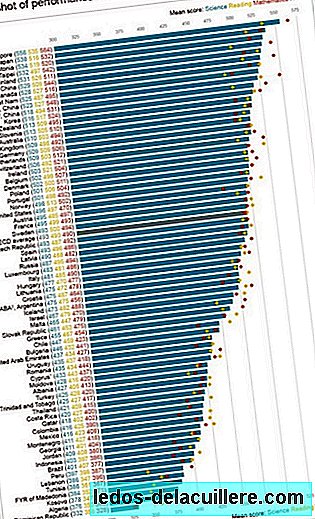Yesterday the data of the PISA 2015 report in which about 540,000 15-year-old students from 71 countries participate. The tests carried out every three years by the Organization for Economic Cooperation and Development (OECD) measure performance in science, reading comprehension and mathematics.
We analyze some conclusions that we can draw from the results of the report and their differences with respect to the results of the 2012 PISA report.
The countries of Asia in the first place
The best ranked country in the three areas worldwide is Singapore, despite lowering in two of them: 556 points in Science, two more than in the previous report; 564 points in Mathematics, nine less, and 535 in Reading, seven points less.
In Science it follows Japan (538) and Estonia (534); in mathematics, Hong Kong (China), with 548 points, and Japan (532); and in Reading, Hong Kong and Canada (both with 527) and Finland (526).

Finland, goes back
The Finnish educational model is the most recognized in Europe, with the best results in the region. However, in this latest edition has receded in the three areas evaluated, especially in Sciences, in which he has obtained 531 points, 14 less than in 2012.
Still, still getting great results and still located well above the average of the European Union and among the top five countries worldwide.
Spain reaches the average
Regarding our country, Spain slightly improves its results with respect to the PISA report of 2012 and for the first time it reaches the OECD average. Students improve in math (They have risen two points obtaining a total of 486, although it is below the average of 490), but three points down in science remaining at the same level as the OECD average that stands at 493.
For its part, in reading comprehension they have risen eight points compared to 2012, standing at 496 points, slightly above the average of the European Union, which stands at 493.
A priori it seems a positive fact that Spain has slightly improved the results compared to 2012 despite the crisis. But you have to keep in mind that The OECD average has fallen overall in the last three years, which has left us better accommodated in the tables in 2015.
Spain, stagnant
Despite the slight improvement in results, Spain has hardly moved from his position since our country began to participate in the report.
"We are as we started, in 2000. In between we have fallen and we have recovered. Education is a thing that changes very slowly, but we have been like this for 15 years," says Professor of Economics at Pompeu University in El Mundo Fabra José García Montalvo.
Spain is situated to a distance school course if compared to Finland and far from excellence.
The report indicates that there are 11% of excellent students when the average in the OECD is 15.3%. In Mathematics, 22% of Spanish students do not reach the most elementary level.
Inequality between autonomous communities
 Source: OECD / Europa Press
Source: OECD / Europa Press For the first time all the Spanish autonomous communities have participated, except Ceuta and Melilla, and a strong reality has been revealed: great educational differences between them.
The best results are for Castilla y León, Navarra and the Community of Madrid, which despite being governed by the same education law, presents a course of advantage over communities such as Andalusia and Extremadura, which are the worst results obtained together to the Canary Islands and Murcia.
In Sciences, Castilla y León is at the top, with 519 points, 26 above the Spanish average (496 points), in Mathematics, Navarra leads the table with 518 points, 32 more than the Spanish average (486), while that in Reading Castilla y León is placed at the head (522), 26 points more than the average.
Ninth country in repeaters
Another striking and worrying fact is that in Spain, one in three students is a repeater. 31% of students repeat course once or twice Compulsory Secondary Education (ESO), 19% more than the OECD average (12%) and 16 more than the EU (16%).
The figure recovers with respect to 2009, when the percentage reached 35%, it is still the ninth country with the highest percentage of repetitive students, standing at the height of Costa Rica, for example.
No country in Latin America stands out

The best position in the region in the three categories was for the Autonomous City of Buenos Aires (Argentina was not included because the sample taken among 7,500 students was insufficient).
In science, the Autonomous City of Buenos Aires occupied the 38th place. Chile the 44th place followed by Uruguay (47), Costa Rica (55), Colombia (57), Mexico (58), Brazil (63), Peru (64) and Dominican Republic (70).
In mathematics, these were the results for Latin America: Autonomous City of Buenos Aires (42), Chile (48), Uruguay (51), Mexico (56), Costa Rica (59), Colombia (61), Peru (62) , Brazil (65), Dominican Republic (70).
In reading, the Autonomous City of Buenos Aires (38), Chile (42), Uruguay (46), Costa Rica (51), Colombia (54), Mexico (55), Brazil (59), Peru (63), Republic Dominican (66).
The countries of the region are at the bottom of the list, the first one appearing, Buenos Aires in 38th place. The country with the worst results in the table, Dominican Republic. It must be taken into account that only nine Latin American countries participate in the evaluation, countries such as Argentina, Ecuador, Panama, Paraguay and Venezuela are not included.
Differences between boys and girls
In Reading, girls have higher performance than their male partners in all the countries analyzed. In Mathematics, boys outperform girls, although the differences are not as great as in Science, where students get significantly better results than students, except in Finland or Bulgaria.
Finland, for its part, is the only country in which girls are more likely to get better results in science than boys.
Socioeconomic Disadvantages

Socio-economic disadvantages draw a gap in terms of educational equality. Countries such as Canada, Denmark, Estonia, Hong Kong (China) and Macao (China) reach high levels of performance and equity in education outcomes.
However, socioeconomically disadvantaged students in OECD countries are almost three times more likely than those favored not to reach the basic level of performance in science. The relationship between socioeconomic status and student performance weakened in nine countries where the average scores in science remained stable.
A poor child is five times more likely to repeat than a rich child, well above the average that is below two.












